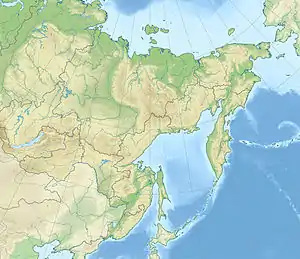Balagan-Tas
Balagan-Tas (Yakut: Балаҕан Таас, Russian: Балаган-Тас) is a cinder cone volcano in Russia. It was discovered by V.A. Zimin in 1939[1] and is one of the main features of the Moma Natural Park.[2]
| Balagan-Tas | |
|---|---|
| Балаган-Тас | |
 Balagan-Tas | |
| Highest point | |
| Elevation | 993 m (3,258 ft) |
| Prominence | 300 m (980 ft) |
| Coordinates | 65.95°N 145.9°E |
| Naming | |
| Native name | |
| Geography | |
| Location | Sakha Republic, Russia |
| Parent range | Chersky Range |
| Geology | |
| Age of rock | 266,000 ± 30,000 years |
| Mountain type | Cinder Cone |
| Last eruption | 1775 |
Description
This volcano is located in the Chersky Range,[3] in the Moma River valley and is the only clearly Quaternary volcano in the area; the existence of another volcano active in the 1770s has not been confirmed.[4] The supposed Indighirsky volcano may be actually Balagan-Tas.[5] Its location has often been given incorrectly.[6]
Balagan-Tas is a volcanic cone with a crater of which little remains. It covers a surface area of 1.8 square kilometres (0.69 sq mi).[7] The crater is 200 metres (660 ft) wide and 40 metres (130 ft) deep, the cone is 300 metres (980 ft) high and has a base diameter of 1,200 metres (3,900 ft).[8] It may be considered a composite volcano.[9] The volcano has generated three lava flows which cover a surface area of 45 square kilometres (17 sq mi).[6] They reach a thickness of 10 metres (33 ft).[7]
The volcano has erupted alkali basalts typical for rift zone volcanoes.[6] Its composition has been characterized as hawaiite.[5] Titanium dioxide contents of 3.81% have been measured. The helium-3/helium-4 ratios approach these associated with mantle plumes.[1]
Balagan-Tas lies on an anticline.[10] It is associated with faulting.[11] Further it is related to the Moma-Zoryansk rift and the Gakkel ridge, which extends to the Laptev sea.[12] The De Long Islands and a potentially Quaternary dyke complex of the Viliga river may also be related.[3] This tectonic activity is related to the interaction between the Eurasian Plate and the North American Plate.[13]
Other volcanoes are found in the neighbourhood.[6] Northwest of Balagan-Tas lies the Uraga Khaya volcano;[14] it is located 66.1°N 145.4°E and is a lava dome formed by rhyolite. Its age is unclear, potassium-argon dating has yielded an age of 16.6 mya but its appearance indicates it may be considerably younger. A further volcano may exist northwest of this centre.[6] A liparite dome named Majak is located at 66.45°N 147.15°E,[7] but it may be the same as Uraga Khaya and the coordinates wrong.[6]
Potassium-argon dating of Balagan-Tas has yielded an age of 266,000 ± 30,000 years ago, comparable to Anyuj volcano.[15] Other sources consider the volcano late Holocene in age,[16] or even as active during historical time.[1] Hot springs are found southeast of Balagan-Tas. They reach temperatures of 30 °C (86 °F),[17] which together with the other activity indicates a hot upper mantle.[1] If reports of activity of the supposed Indighirsky volcano in the 1770s refer to Balagan-Tas,[7] this volcano may have had historical activity,[7] one of the few outside of Kamchatka in continental Asia.[18]
References
- Grachev, A. F. (31 October 2003). "The Arctic rift system and the boundary between the Eurasian and North American lithospheric plates: New insight to plate tectonic theory". Russian Journal of Earth Sciences. 5 (5): 307–345. doi:10.2205/2003ES000135. S2CID 129810650.
- "Moma Natural Park Official site". Archived from the original on 2019-09-29. Retrieved 2019-11-06.
- Silantyev, S.A.; Bogdanovskii, O.G.; Fedorov, P.I.; Karpenko, S.F.; Kostitsyn, Yu.A (June 2004). "Intraplate magmatism of the De Long Islands: A response to the propagation of the ultraslow-spreading Gakkel Ridge into the passive continental margin in the Laptev Sea" (PDF). Russian Journal of Earth Sciences. 6 (3): 172. doi:10.2205/2004ES000150. Retrieved 23 September 2016.
- Maria Shahgedanova (2002). The Physical Geography of Northern Eurasia. Oxford University Press. p. 300. ISBN 978-0-19-823384-8.
- Whitford-Stark 1983, p. 199.
- Fujita, Cambray & Velbel 1990, p. 110.
- Whitford-Stark 1987, p. 24.
- Whitford-Stark 1987, p. 48.
- Whitford-Stark 1987, p. 29.
- Whitford-Stark 1983, p. 213.
- Matveyenko, V. T.; Shatalov, E. T. (February 1963). "Fractures, Magmatism and Mineralization in the Northeast of the U.s.s R. (Part 1 of 2)". International Geology Review. 5 (2): 153. Bibcode:1963IGRv....5..127M. doi:10.1080/00206816309473762.
- Richard E. Ernst; Kenneth L. Buchan (1 January 2001). Mantle Plumes: Their Identification Through Time. Geological Society of America. p. 213. ISBN 978-0-8137-2352-5.
- Whitford-Stark 1987, p. 39.
- Fujita, Cambray & Velbel 1990, p. 111.
- Pevzner, M. M.; Gertsev, D. O.; Romanenko, F. A.; Kushcheva, Yu. V. (6 July 2011). "The first data on isotopic age of Anyui volcano (Chukotka)". Doklady Earth Sciences. 438 (2): 737. Bibcode:2011DokES.438..736P. doi:10.1134/S1028334X11060109. S2CID 128991774.
- Whitford-Stark 1987, p. 35.
- Fujita, Cambray & Velbel 1990, p. 112.
- Whitford-Stark 1987, p. 31.
Sources
- Whitford-Stark, J. L. (1987). "A Survey of Cenozoic Volcanism on Mainland Asia". Geological Society of America Special Papers. Vol. 213. pp. 1–74. doi:10.1130/SPE213-p1. ISBN 978-0-8137-2213-9. ISSN 0072-1077.
{{cite book}}: Missing or empty|title=(help) - Whitford-Stark, J.L. (December 1983). "Cenozoic volcanic and petrochemical provinces of Mainland Asia". Journal of Volcanology and Geothermal Research. 19 (3–4): 193–222. Bibcode:1983JVGR...19..193W. doi:10.1016/0377-0273(83)90110-5.
- Fujita, Kazuya; Cambray, F.William; Velbel, Michael A (June 1990). "Tectonics of the Laptev Sea and Moma rift systems, northeastern USSR". Marine Geology. 93: 95–118. Bibcode:1990MGeol..93...95F. doi:10.1016/0025-3227(90)90079-Y.
Further reading
- Argunov, M. S., and S. I. Gavrikov. "Balagan-Tas, an early Quaternary volcano." Izv. Acad. Sci. USSR 8 (1960): 72–74.
- Global Volcanism Program, 2013. Balagan-Tas (301805) in Volcanoes of the World, v. 4.5.0. Venzke, E (ed.). Smithsonian Institution. Downloaded 24 Sep 2016 (http://volcano.si.edu/volcano.cfm?vn=301805). https://dx.doi.org/10.5479/si.GVP.VOTW4-2013
- Rudich, K. N. "Late Quaternary volcano Balagan-Tas." Presentday Volcanism in Northeast Siberia, edited by: Rudich, KN, Nauka, Moscow (1964): 3-44.